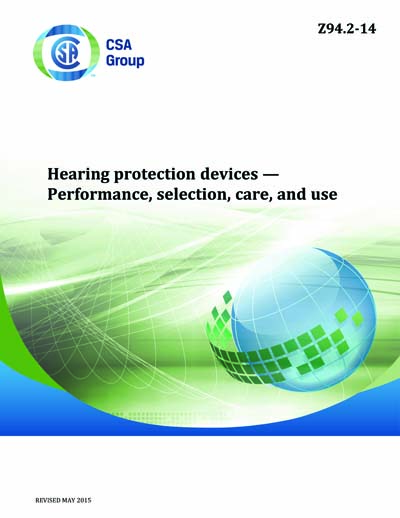Historical
CSA Z94.2-2014
Z94.2-14 - Hearing protection devices - Performance, selection, care, and use
Preface
This is the seventh edition of CSA Z94.2, Hearing protection devices - Performance, selection, care, and use. It supersedes previous editions published in 2002, 1994, 1984, 1979, 1974, and 1965. This edition expands on performance requirements and the rating schemes that might help the user select hearing protection devices. It now includes the widely used noise reduction rating (NRR) and an applicable derating scheme. This edition no longer includes physical performance and related testing requirements (such performance is no longer sought by Canadian users). It addresses acoustical performance measurements and includes revisions in the packaging marking requirements to clarify the use of the various ratings. Clauses 8 to 12 regarding the selection, care, and use of hearing protection devices (HPDs) have been expanded to include issues related to style and functions of hearing protectors not mentioned in previous editions, as well as the potential use of field attenuation estimation systems (FAES). Table 4, which specifies the selection of HPDs based on noise exposure levels, now requires octave-band noise measurements at exposures greater than 105 dBA. Although users of hearing protection devices are required to follow the criteria in Clauses 8 to 12 in order to comply with this Standard, reference should also be made to applicable local occupational health and safety regulations, which can require additional or superior performance. The CSA Subcommittee on Hearing Protection recognizes that significant variations in performance (as great as ± 20 dB attenuation) can occur depending on how an HPD is used. This Standard emphasizes the importance of a comprehensive hearing loss prevention program, including hazard assessment and instruction on the careful selection, proper wearing, and high-quality maintenance of hearing protection devices. It is the opinion of the Subcommittee that wearing HPDs without proper selection, care, and use can result in significantly lower attenuation for the user than that obtained from the tests specified in this Standard. This Standard should be used in conjunction with CSA Z1007, Management of hearing loss prevention programs, which is currently under development. CSA Z1007 covers all aspects of the creation and management of hearing loss prevention programs. CSA gratefully acknowledges the financial and in-kind support from the Canadian government departments responsible for occupational health and safety for the development of this edition of the Standard.Introduction
This Standard deals with hearing protection devices (HPDs). They are used to reduce the noise level that reaches the ear of noise-exposed people and to reduce the annoyance and/or hazard of noise exposure. Of the many characteristics of HPDs, such as attenuation, comfort, and communication ability, this Standard focuses on attenuation. It specifies two methods of measuring the real-ear attenuation provided by HPDs and outlines how to use the results to estimate the sound levels reaching the protected ear. Several procedures for estimation of protected levels while wearing HPDs of varying accuracy and complexity are included in this Standard. The user may decide which one to use. Other related issues such as fit, care, use, overprotection, selection, and training are also addressed. The companion Standard, CSA Z1007, contains more detailed information. CSA Z1007 covers the use of HPDs as part of a comprehensive hearing loss prevention program.Scope
1.1 Clauses 4 to 7 cover performance, acoustical testing, and packaging requirements for personal hearing protection devices (HPDs). Clauses 8 to 12 cover the selection, care, and use of HPDs, which will contribute to an effective hearing loss prevention program. 1.2 The following types of HPDs are covered in this Standard: a) earplugs (including semi-inserts); b) earmuffs; and c) helmets, with or without electronic communication capabilities. 1.3 In this Standard, shall is used to express a requirement, i.e., a provision that the user is obliged to satisfy in order to comply with the standard; should is used to express a recommendation or that which is advised but not required; and may is used to express an option or that which is permissible within the limits of the standard. Notes accompanying clauses do not include requirements or alternative requirements; the purpose of a note accompanying a clause is to separate from the text explanatory or informative material. Notes to tables and figures are considered part of the table or figure and may be written as requirements. Annexes are designated normative (mandatory) or informative (non-mandatory) to define their application.Content Provider
CSA America, Inc. [csa]






